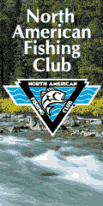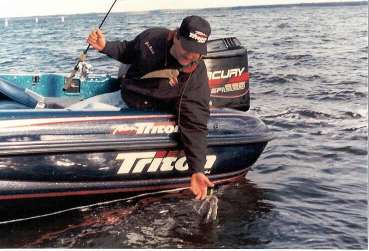





















Free 90 day Risk free trial offer click
here

|
Lucky charm walleyes
By John Kolinski
EDITOR’S NOTE: John Kolinski is an eight-time championship qualifier
during
his seven years of professional fishing on the Professional Walleye
Trail and
the Masters Walleye Circuit.
Any walleye angler who says they’d rather be lucky than good is only
trying
to be modest. In tournament fishing circles, it pays to be good more
often
than it pays to be lucky. We’ve all been in situations where one boat
among a group seems to be catching most of the fish, and we’ve all been
in a boat where one angler consistently gets the most action.
I usually tell my partners that I’m just that good when I’m the one
putting
the fish in the boat. In reality, however, there is always some subtle
difference in presentation, location or equipment that gives me an edge.
Call them my lucky charms, if you must.
 Any springtime walleye angler is only as good as his or her boat control.
Often, we’re dealing with fish that are relating to specific current breaks
or structure edges. Stay on top of them and you’ll catch your share. Miss
the target area by a few feet and you’ll strike out. Wind is another factor,
and there never seems to be a shortage of it in April. One advantage I
enjoy while vertical jigging or battling the wind is the
Any springtime walleye angler is only as good as his or her boat control.
Often, we’re dealing with fish that are relating to specific current breaks
or structure edges. Stay on top of them and you’ll catch your share. Miss
the target area by a few feet and you’ll strike out. Wind is another factor,
and there never seems to be a shortage of it in April. One advantage I
enjoy while vertical jigging or battling the wind is the  205 I’ve been running for the past couple of years. We’ve all seen boats
that get thrown a foot or two off course every time a gust of win comes
up. That doesn’t happen with the Triton. Its design keeps plenty of keel
in the water when it’s not under power. It grabs hold and sticks, and it
205 I’ve been running for the past couple of years. We’ve all seen boats
that get thrown a foot or two off course every time a gust of win comes
up. That doesn’t happen with the Triton. Its design keeps plenty of keel
in the water when it’s not under power. It grabs hold and sticks, and it
keeps you on the fish while others fight for control. Your bow-mounted
trolling motor is no less important than the boat when it comes to staying
on line and staying on top of the fish in windy conditions or swift current.  Maxum 101 has been the perfect fit for my
Maxum 101 has been the perfect fit for my
Triton. With 101 pounds of thrust drawn from a 36-volt system, it’s
got the
power to take me anywhere in any conditions, and the battery efficiency
to go
from dawn to dusk. I can use the Minnkota to slip the current or slow
down a drift, and I can use it to move quickly from spot to spot when casting
shoreline. It’s anasset for pulling live bait rigs, too, especially in
shallow water where
stealth is preferred over even the quietest-running kicker motors.
When it comes to jigging situations, in my opinion an angler is only as
good as the equipment he or she is using. Again, I’ve been in situations
where the only difference between catching fish and just fishing was the
rod, reel and line being used. Early season walleyes aren’t always the
most aggressive, and the ability to
separate those subtle bites from a rock or a clam shell is critical.
I’ve
gradually become a firm believer in  Fireline for several reasons.
Fireline for several reasons.
First of all, it’s tough. I use a lot of the 6-pound test, 2-pound
diameter
high visability green in vertical jigging and casting applications.
With all
those razor-sharp zebra mussels that are infesting our waters, I’ve
been able
to keep a jig in the water far longer than anglers who accompany me
using
traditional monofilament lines. I also spend less time hung up on snags.
I literally can feel a log when my line rubs across it, and I can often
lift my jig over before it gets snagged. If it does get snagged, Fireline
is tough enough to pull it loose in many cases before the line breaks.
Perhaps the biggest advantage I’ve found in using Fireline is the quick,
solid hooksets it imparts. The sensitivity lends itself to quicker reaction
by the angler, and with no stretch, hooksets are usually solid and deep.
Some anglers express concern about losing fish once they’ve hooked them
because of the no-stretch factor. When matched with the right rod and reel
combination, that’s not an issue. I’ve found Berkley’s medium-heavy action,6-foot
Series One jigging sticks and lightweight  T500 spinningreels a perfect fit for Fireline. The rod has the quick tip
I like for
T500 spinningreels a perfect fit for Fireline. The rod has the quick tip
I like for
hooksets, but it’s also limber enough to let the walleye work once
it’s
hooked. The T500 has one of the smoothest drag systems for any reel
its size,
and it’s critical that a fish can take line when the stretch factor
doesn’t
exist. Your choice of jig styles can give you an edge, too. Current
situations call for current-cutting heads (flat heads, arrow heads, bullet
heads, banana heads, etc.) that allow you to stay directly on top of your
jig. That’s critical for several reasons. The more vertical you can fish,
the lighter jig you can use, which makes it easier for a lazy walleye to
inhale your bait. You’ll also have more feel and quicker reaction on those
light-biting fish when you are directly over them as opposed to 20 feet
ahead of them with a big bow in your line.
In other situations, such as pitching jigs in lakes or vertical jigging
in
little or no current, buoyancy is an important factor. Sometimes, walleyes
want a jig that’s pounding the bottom and creating a stir. Other times,
a
slower rate of fall works better. Wind and casting distance often dictate
what size of jig we must use, so adjustments have to be made in body style
to achieve the desired rate of fall. In general, hair jigs are more buoyant
than bucktail, which is more buoyant than maribou. But if the walleyes
are foraging on small minnows, a hair jig might be too bulky and bucktail
might fall too fast. Then you might want to go with some sort of
plastic to add buoyancy while retaining a small profile. There are also
times when fussy walleyes won’t touch a jig with any kind of body. That’s
when I go to a plain jig head tipped with a minnow. I like long-shanked,
wide-gapped hooks in these jigs that I believe aid in setting
the hook, and I like heads with slight stand-up properties that keep
the bait
in the fish’s face rather than dragging below the jig on the bottom.
Finally, there’s no question that an angler’s position in the boat often
dictates who will catch the most fish. If I’m casting a shoreline or a
mid-lake point and operating from the front of the boat, it follows that
I’ll get first crack at the fish that are actively feeding. Anglers further
back in the boat are often well-advised to work the deeper stretches of
the break. The same holds true when fishing eddies in river situations.
If you know where the fish are likely to be, you’ll probably be the one
who catches them. Experience has proven to me that the most active fish
will be at the top of the eddy, but the largest walleyes can often be found
at the bottom end where the dead water wraps around toward shore. Target
those two areas and you’ll have another advantage over the competition.
I’d rather be good than lucky, but neither would be likely without
my “lucky
charms.”

Walleyes Inc. web site is maintained
by Randy
Tyler Fishing the In-Fisherman Professional Walleye Circuit, Masters
Walleye Circuit, RCL and the Team Walleye Circuit. All rights reserved.
Copyright 1999/2001
Please visit these site sponsors
Daiichi/Tru-Turn Hooks,
Lindy
Little Joe,
R-A.M Mounting Systems,
Ranger
boats, Mercury Marine, Bedford
Sales , Hamby's Beaching Bumpers,
Goldeneye
Marine products, Panther
Marine Products, Webfoots body
sock, Bait Rigs Tackle
|



 Any springtime walleye angler is only as good as his or her boat control.
Often, we’re dealing with fish that are relating to specific current breaks
or structure edges. Stay on top of them and you’ll catch your share. Miss
the target area by a few feet and you’ll strike out. Wind is another factor,
and there never seems to be a shortage of it in April. One advantage I
enjoy while vertical jigging or battling the wind is the
Any springtime walleye angler is only as good as his or her boat control.
Often, we’re dealing with fish that are relating to specific current breaks
or structure edges. Stay on top of them and you’ll catch your share. Miss
the target area by a few feet and you’ll strike out. Wind is another factor,
and there never seems to be a shortage of it in April. One advantage I
enjoy while vertical jigging or battling the wind is the